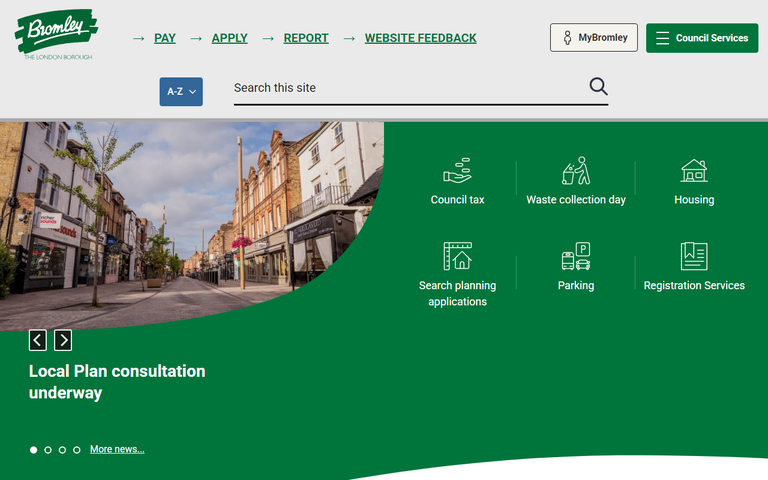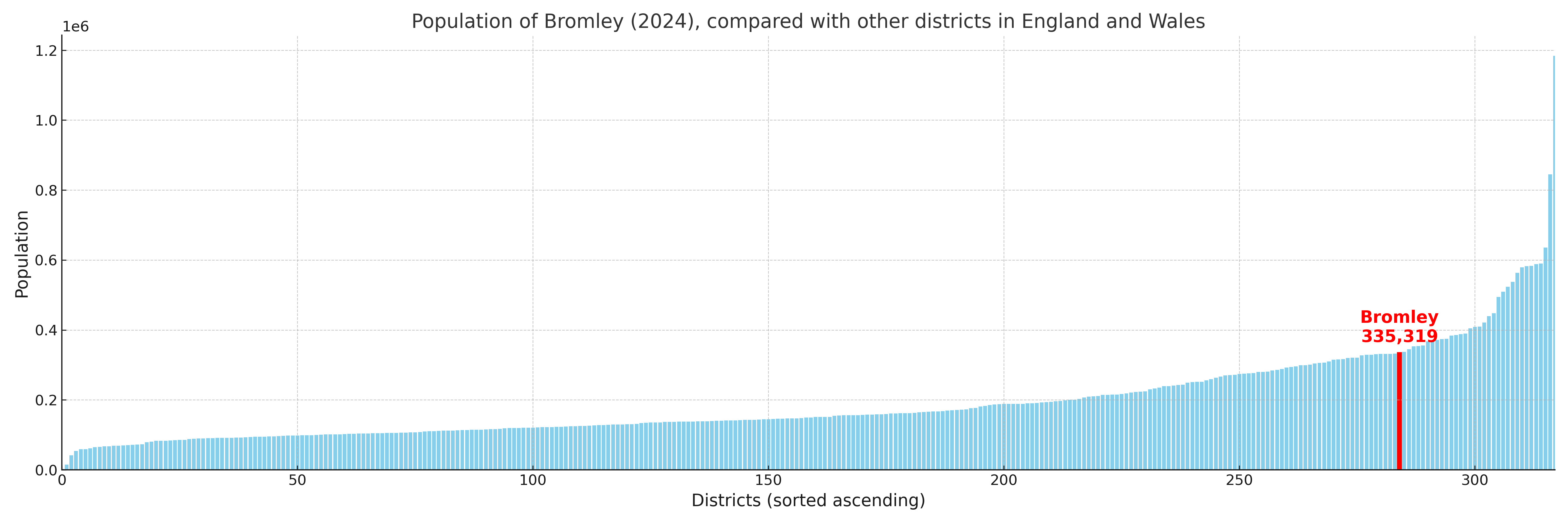Bromley
§ This page gives an overview of the Bromley local authority district, bringing together key facts, maps, and data to help you quickly understand the area. One of 361 district profiles on Baseview.
Overview ⁞ Bromley is the largest London borough by area, located in the southeast and containing extensive green belt land. It has a mix of suburban neighbourhoods, rural villages, and commercial hubs, making it a commuter-friendly area with a semi-rural feel.
Bromley Boundary Map
This map shows the official boundary of the Bromley local authority district, based on the latest geographic data published by the Office for National Statistics (ONS). It provides a clear view of the district’s extent and helps you understand how the area fits within the wider regional and national landscape.
Contains OS data © Crown copyright and database right 2025. Source: Office for National Statistics licensed under the Open Government Licence v3.0.
The administrative boundary of Bromley can also be viewed on OpenStreetMap: District Boundary of Bromley.
Key Facts about Bromley
What region is Bromley in? Bromley is in the Greater London, an administrative region and a ceremonial county in England.
Is Bromley a city? No, Bromley is not a city. (Note: the UK has 76 officially designated cities.)
Who governs Bromley? The local government for this district is: The London Borough of Bromley (London Borough).
▶ Official website of The London Borough of Bromley 🔗 bromley.gov.uk

Which police force covers Bromley? Policing in Bromley is provided by Metropolitan Police Service 🔗 met.police.uk, which serves 32 London Boroughs.
Bromley in International Geographies
In the International Territorial Levels (ITLs) hierarchy, Bromley is an ITLs Level 3 area:
- (ITL 1) London
- (ITL 2) ⇒ Outer London - South
- (ITL 3) ⇒⇒ Bromley
The International Territorial Levels are used by OECD member countries for statistical purposes to classify administrative areas. We have this listable page for easy browsing of ITL names and codes: International Territorial Levels.
Constituencies in Bromley
Bromley is divided into 4 parliamentary constituencies, listed below in alphabetical order.
A constituency is a specific geographical area that elects one Member of Parliament (MP) to represent them in the House of Commons. The United Kingdom is divided into 650 parliamentary constituencies, 75 of them are in Greater London (covering 32 London boroughs). We have this list page for easy browsing of all UK parliamentary constituencies: List of Constituencies.
Wards in Bromley
Bromley is divided into 22 wards, listed below in alphabetical order.
- Beckenham Town & Copers Cope
- Bickley & Sundridge
- Biggin Hill
- Bromley Common & Holwood
- Bromley Town
- Chelsfield
- Chislehurst
- Clock House
- Crystal Palace & Anerley
- Darwin
- Farnborough & Crofton
- Hayes & Coney Hall
- Kelsey & Eden Park
- Mottingham
- Orpington
- Penge & Cator
- Petts Wood & Knoll
- Plaistow
- Shortlands & Park Langley
- St Mary Cray
- St Paul's Cray
- West Wickham
In the UK, a ward is a subdivision of a local authority area, used mainly for electoral and statistical purposes. Defined by the ONS, wards represent the primary unit for local elections, each returning one or more councillors to the local council. Wards are also used as a key geography for presenting population and census data.
Parishes in Bromley
Bromley is entirely unparished—there are no civil parishes in this local authority district.
Parishes are the lowest tier of local government; where they don’t exist, those very local services and representation sit directly with the principal council.
Built-up Areas in Bromley
Bromley covers 10 built-up areas, listed below in alphabetical order.
- Bexley *
- Bromley *
- Croydon *
- Greenwich *
- Knockholt Pound *
- Lewisham *
- Southwark *
- Swanley *
- Tatsfield *
- Well Hill *
In the UK, a Built-up Area (BUA) is a continuous urban area of at least 20 hectares (0.2 km²), defined by the ONS as land where buildings are generally no more than 200 metres apart, such as towns, cities, or large villages. (Note: A BUA name marked with an asterisk (*) indicates that the area is situated partly in the district of Bromley.)
Bromley compared with other districts in the UK
This section shows how Bromley compares with other local authority districts in the UK, using a variety of measures and rankings.
Bromley has 22 electoral wards.

Bromley has a population of 335,319 (2024 mid-year estimate by ONS)

More local statistics and data for Bromley can be found on the ONS statistics for Bromley.